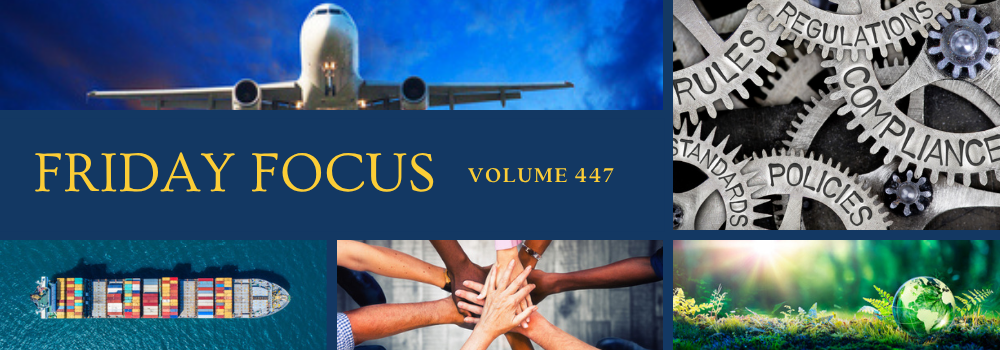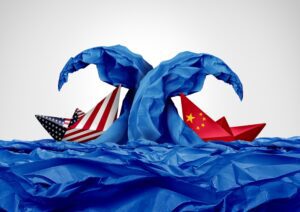WITA’s Friday Exchange Podcast: Bad Ad Vibes and Trade Wars
On this week of WITA’s Friday Exchange, trade experts discuss President Trump’s pique over anti-tariff ads and President Reagan’s legacy, the new U.S.–Australia agreement on critical minerals, and the prospect for trade deals between the U.S. and its Asian trading partners, including an expected meeting between President Trump and President Xi.
Featured Speakers:
Introduction: Kenneth Levinson, CEO, WITA – the International Trade Membership Association
Wendy Cutler, Senior Vice President, Asia Society Policy Institute; former Acting Deputy U.S. Trade Representative, Office of the U.S. Trade Representative
Daniel Mullaney, Non-Resident Senior Fellow, Atlantic Council; former Assistant U.S. Trade Representative for Europe and the Middle East, Office of the U.S. Trade Representative
Dawn Shackleford, President at Looking Glass Trade, LLC; former Executive Director for Trade Agreements Policy & Negotiations, Department of Commerce; former Assistant USTR for WTO & Multilateral Affairs
Moderator: Joe Damond, Chair of International Trade Policy and Global Life Sciences, Crowell Global Advisors; former Deputy Assistant U.S. Trade Representative for Asia and Pacific, Office of the U.S. Trade Representative
Watch the Video on YouTube | Listen on Spotify or Apple Podcasts
Recorded at 9:00 AM ET on 10/24/2025 | WITA
Escalate to Negotiate: How Europe Should Respond to Chinese Export Restrictions
In a series of announcements in early October, the Chinese ministry of commerce codified and tightened export restrictions on “rare earth-related technologies and other items”. The new rules limit exports of all Chinese technologies needed for mining, processing, refining and recycling—along with core technologies used in the battery supply chain, from cathode and anode materials to the industrial machines, particularly those that produce batteries for electric vehicles (EVs). All these goods now need export licenses on national security grounds; nothing leaves China without official approval (and if a product has a military-linked end-use, its manufacturers should assume that their request for an export license will be denied).
Even before this round of restrictions, approvals crawled: by early September, Beijing had cleared under 15% of rare earth licence requests from European companies. The situation will likely get much worse. The new regulations go further, applying to every exporter in China and every intermediary, including banks, freight companies and e-commerce platforms.
Europeans should take particular note of announcement 61, which allows China to apply legal provisions beyond its borders. In this manner, Beijing is now openly copying the very tactics it criticised in Washington—using its long-arm jurisdiction to force other countries to bend to its will. Practically, this means that if, for example, a Korean company were to invest in a battery plant in Europe that uses Chinese machines, equipment or rare earths, Beijing would have legal grounds to interfere in the investment.
10/21/2025 | Tobias Gehrke & Janka Oertel | European Council on Foreign Relations
A New Pacific Trade Highway
When President Trump announced a new 100% tariff on Chinese imports, in retaliation for Beijing’s latest export controls on rare earth elements, markets saw only the headline risk. But the real story lies beyond the ticker: a structural reordering of global trade. The world’s supply chains, long anchored to the Chinese mainland, are splintering.
Capital is scattering across Asia’s periphery, and shipping routes that once followed predictable trans-Pacific lines are being redrawn into a new web of uncertainty and opportunity. Alongside an eastward turn worth $100 billion in investment, the trends of the last 30 years of global financial flows are being upended.
The tariffs, nominally intended to protect American industry, have become a catalyst rather than a disruption. China’s tightening of export rules on rare earths, a sector that underpins global technology and defense manufacturing, has already caused shipments to fall sharply this autumn. That decline is deliberate: Beijing is weaponizing its market dominance to exert pressure on Washington and signal that supply chains remain a form of leverage. The Trump administration’s countermeasures (broad tariffs and new fees on Chinese-built ships docking in American ports, extensively disrupting the transshipment trend of recent years) seek to contain that leverage, yet they also deepen the fragmentation of global commerce.
Rather than simply pushing prices up, these measures are accelerating a diversification that had already begun. Companies that once treated China as the irreplaceable factory of the world are now spreading their risks across what trade analysts call a “China+1” or even “China+N” model.
Vietnam, Malaysia, Thailand, and India are attracting new investment in electronics, textiles, and automotive components as manufacturers seek to route goods through lower-tariff jurisdictions. The result is not a clean decoupling but a messy rewiring. Supply chains have become a geopolitical map of caution: firms are trading efficiency for resilience, scale for redundancy.
10/17/2025 | Jake Scott | Foundation for Economic Education
The Polar Silk Road That Could Sideline the West
The Northern Sea Route, once a frozen frontier mapped by explorers and sealed by ice for most of the year, is fast becoming one of the world’s most strategic corridors. On October 14, 2025, Russia and China signed a far-reaching agreement to jointly develop this Arctic passage, formalizing years of collaboration and transforming it into the northern backbone of the so-called Polar Silk Road.
The implications extend far beyond trade. The new pact binds two continental powers through a maritime artery that not only shortens distances but also redefines control over global logistics. The route between Shanghai and Rotterdam or Hamburg via the Arctic is approximately 7,000 kilometers shorter than through the Suez Canal, cutting transit times by nearly 40 percent and fuel costs by over 20 percent. For Moscow, it is a lifeline to Asian markets amid Western sanctions. For Beijing, it is an escape hatch from the geopolitical choke points of the Indian Ocean and the Middle East.
Strategic Logic and Economic Scale
Arctic shipping volumes along the Northern Sea Route have already hit 400,000 tons in 2025, an unprecedented level that marks the corridor’s transition from experiment to commercial reality. Moscow projects annual cargo traffic could reach tens of millions of tons by 2030, driven by liquefied natural gas exports and containerized trade between East Asia and Europe.
The route’s advantages are tangible. Compared with the Suez Canal or Cape of Good Hope passages, the Arctic shortcut saves up to 20–30 days of navigation time and nearly 40 percent of distance. During its 2021 pilot voyages, China’s shipping giant COSCO saved 6,900 tons of fuel and over $9 million across 14 trips. While the seasonal window remains limited, the long-term ambition is unmistakable: a year-round, icebreaker-supported Arctic corridor operating under joint Sino-Russian management.
This collaboration signals a profound reordering of trade geography. The melting Arctic is not just a climate story—it is a logistical revolution that redraws the map of Eurasian connectivity. For both powers, the Northern Sea Route is an answer to vulnerability: Russia’s dependence on constrained western markets, and China’s reliance on southern sea lanes policed by the U.S. Navy.
10/19/2025 | Ambrus Béla | Ambrus Béla’s Geopolitical Outlooks
Trump’s Film Tariff Threat Exposes Disconnect on Streaming Economics
U.S. President Donald Trump’s proposed 100% tariff on foreign-made films has resurfaced. First floated in May, then quietly shelved, the threat returned this fall with Trump claiming other countries are “stealing candy from a baby” in the form of Hollywood. Entertainment stocks—including Netflix, Disney, Warner Bros. Discovery, and Paramount—dropped roughly 5% on the initial announcement. In September, markets barely reacted. Investors have learned these threats rarely materialize, but the proposal exposes dangerous blind spots about streaming’s global supply chain.
The timing is particularly ironic. Just weeks ago, Netflix staged Creative Asia at the Busan International Film Festival, announcing expanded Asian initiatives. Meanwhile, Sony Pictures CEO Tony Vinciquerra told investors that “Crunchyroll is going to be our primary growth driver” —with the anime streamer projected to generate over 40% of Sony Pictures’ operating profit over the next two years, more than theatrical releases. Crunchyroll has 17 million paid subscribers and is expanding aggressively into India, Brazil, Mexico, and Southeast Asia.
These aren’t side bets. They’re core strategy. Trump’s tariff would penalize exactly the content driving subscriber growth while theatrical becomes a secondary revenue stream.
The policy targets the wrong metric entirely. Global theatrical box office represents roughly 1% of entertainment industry revenue, according to PwC. Streaming subscriptions, advertising, gaming, and licensing drive the other 99%. Yet Trump wants to tariff “foreign-made” films—a term that’s meaningless when Netflix greenlights in LA, films in Toronto, uses VFX in London and Vancouver, and premieres globally. Which part is “foreign”?
10/16/2025 | Douglas Montgomery | StreamTV Insider
WITA – We put the community in trade community.
Information about upcoming WITA and trade community events






